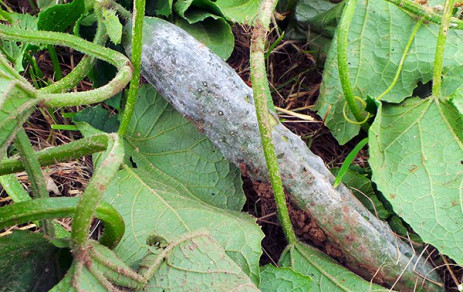May 1, 2020Excess water raises disease issues in vegetables
The National Weather Service stated that “2018 was the wettest year on record in Pennsylvania.” This past 2019 summer was looking like another wet year, but the rains shut off mid-summer.
Excess water can be problematic in that it can lead to soil compaction (if worked while wet), soil erosion, and loss of nutrients. It can also create an ideal environment for several diseases such as phytophthora blight. The disease thrives in low-lying, poorly drained areas of a field, which was prevalent in the past two years. While there are some fungicides labeled, this is a problem that can be addressed by other means, and planning starts NOW!
When scientists and extension educators talk about phytophthora blight (caused by Phytophthora capsica), we generally refer to it as a fungus. But in reality, it is a totally different organism and classified as an oomycete. These are close relatives of algae. A certain portion of its life stage is spent as a swimming spore. Those wet, low-lying fields serve as a ‘swimming pool’ for this organism as it searches out for a host.
Knowing the lay of your land and its history can help determine the planting location of susceptible crops. If that is not an option, then anything that can be done to increase the draining of your soil is a benefit. It could be something as labor and money intensive as installing subsurface drainage to something more passive like a yearly cover crop program. An additional step might be planting on raised or dome-shaped beds to help provide better soil drainage. These are just a few of the options available to address poor drainage/standing water issues. In addition, consider the movement of footwear and equipment through these areas. Mud stuck to surfaces can easily spread the organism from infested to clean field.
Crown rot, Phytophthora blight can cause crown rot in pumpkins. Photo: Tom Butzler/Penn State
As with any disease, the rotation of crops is a critical management tool. Unfortunately, the disease has a large number of susceptible vegetable species. Rotation from pumpkins (Cucurbitaceae) to peppers (Solanaceae) to snap beans (Leguminosae) wouldn’t work as all three are susceptible. Crops in the grass family would fit into the rotation for phytophthora blight management.
Fungicides should be a choice of last resort. Once the disease starts and gets a toehold on the crop, it can be very difficult to control. Many of the labeled fungicides are effective if applied preventatively or as close to the start of the initial disease. Depending on weather conditions, there is a possibility that several fungicide applications might be needed to finish off the season. This strategy will require scouting, weather patterns, and attention to field conditions.
Below are tables from the 2020/2021 Mid-Atlantic Commercial Vegetable Production Recommendations Guide for the most Phytophthora capsica susceptible crops.
Cucumbers: Fungicide recommendations for phytophthora crown and fruit rot of cucumber. Tables from 2020/2021 Mid-Atlantic Commercial Vegetable Production Recommendations
Pumpkins: Fungicide recommendations for phytophthora crown and fruit rot of pumpkins and winter squash. Tables from 2020/2021 Mid-Atlantic Commercial Vegetable Production Recommendations
 Peppers: Fungicide recommendations for phytophthora blight of peppers. Tables from 2020/2021 Mid-Atlantic Commercial Vegetable Production Recommendations
Peppers: Fungicide recommendations for phytophthora blight of peppers. Tables from 2020/2021 Mid-Atlantic Commercial Vegetable Production Recommendations
– Tom Butzler, Extension educator, Penn State University
Photo at top: Phytop blight fruit rot, white fungal growth of Phytophthora capsica on cucumber fruit. Photo: Tom Butzler/Penn State



















